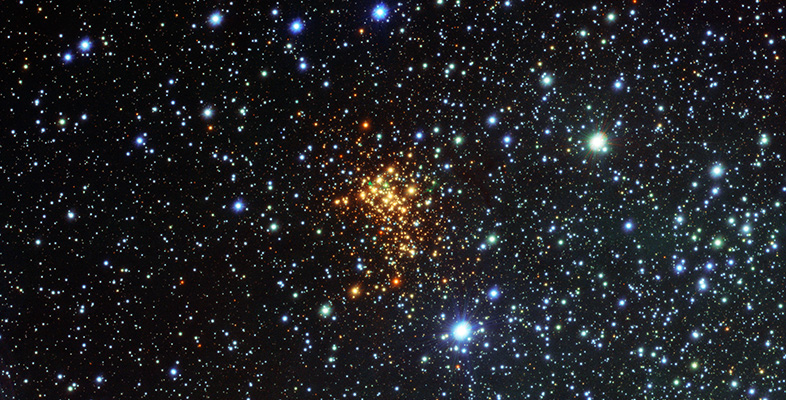Acknowledgements
This free course was adapted from S284 material written by Judith Croston. It was edited for OpenLearn by Andrew Norton.
Except for third party materials and otherwise stated (see terms and conditions), this content is made available under a Creative Commons Attribution-NonCommercial-ShareAlike 4.0 Licence.
The material acknowledged below is Proprietary and used under licence (not subject to Creative Commons Licence). Grateful acknowledgement is made to the following sources for permission to reproduce material in this free course:
Figures
Course image: ESO / VPHAS+ Survey / N. Wright, https://commons.wikimedia.org/wiki/File:Surprise_Cloud_Around_Vast_Star.jpg, This file is licensed under the Creative Commons Attribution 4.0 International license, https://creativecommons.org/licenses/by/4.0/deed.en
Figure 1 How information is stored in a simple (greyscale) astronomical image: adapted from an image by George J. Bendo http://www.jb.man.ac.uk/~gbendo/home.html. This file is licensed under the Creative Commons Attribution 4.0 International (CC BY 4.0) licence, https://creativecommons.org/licenses/by/4.0/
Figure 2 An illustration of apparent magnitudes: adapted from SpaceFM
Figure 3 Photometric apertures (dashed circles) placed on images to measure the flux of (a) two stars of different magnitudes and (b) an extended galaxy: adapted from https://www.spacetelescope.org/projects/fits_liberator/m35data/. This file is licensed under the Creative Commons Attribution 4.0 International (CC BY 4.0) licence, https://creativecommons.org/licenses/by/4.0/
Figure 5 Images of (a) a globular cluster and (b) a galaxy: adapted from images by http://archive.eso.org/dss/dss. This file is licensed under the Creative Commons Attribution 4.0 International (CC BY 4.0) licence, https://creativecommons.org/licenses/by/4.0/
Figure 7 Stars as extended astronomical objects: (a) the Sun, taken by the SOHO mission and (b) the nearby giant star, Gruis: (a) © courtesy of SOHO/[instrument] consortium. SOHO is a project of international cooperation between ESA and NASA; (b) © ESO/José Francisco (josefrancisco.org), https://www.eso.org/public/unitedkingdom/images/eso1741a/. This file is licensed under the Creative Commons Attribution 4.0 International (CC BY 4.0) licence, https://creativecommons.org/licenses/by/4.0/
Figure 8 Sketches by Lord Rosse: out of copyright. Adapted from The Earl of Rosse (1805) ‘Observations on the Nebulae’, Philosophical Transactions of the Royal Society, 150(499), pp. 499–514. Available at: https://www.jstor.org/stable/108449
Figure 9 R-band images of the five main types of extended objects seen in optical images: images adapted from Digitized Sky Survey, https://archive.stsci.edu/dss/acknowledging.html
Figure 10 The Crab nebula viewed across the extremes of the electromagnetic spectrum: © Cherenov Telescope Array CTA, https://www.cta-observatory.org/science/gamma-rays-cosmic-sources/. This file is licensed under the Creative Commons Attribution 4.0 International (CC BY 4.0) licence, https://creativecommons.org/licenses/by/4.0/
Figure 11 The Andromeda galaxy in optical (left) and infrared (right) emission: left image (optical): © Robert Gendler, http://www.robgendlerastropics.com; right image (infrared): © ESA/Herschel/PACS/SPIRE/J. Fritz, U. Gent.
Figure 12 The galaxy NGC 6964 in optical (left) and radio (right) emission: © Prof. Dr. Tom Oosterloo.
Figure 13 Examples of narrow-band images: (a) © Michael Borman; (b) © NASA and the Space Telescope Science Institute (STScI).
Figure 14 The Milky Way, as viewed in a panoramic image from a particularly dark Southern Hemisphere site: © Bruno Gilli and ESO, https://www.eso.org/public/unitedkingdom/images/milkyway/. This file is licensed under the Creative Commons Attribution 4.0 International (CC BY 4.0) licence, https://creativecommons.org/licenses/by/4.0/
Figure 15 Deep survey by the Hubble Space Telescope of a very small area of sky: © NASA; ESA; G. Illingworth, D. Magee, and P. Oesch, University of California, Santa Cruz; R. Bouwens, Leiden University; and the HUDF09 Team.
Figure 16 The positions of millions of galaxies from the Two Micron All Sky Survey (2MASS): © Smithsonian Astrophysical Observatory.
Figure 17 A 3D map of the sky made from a galaxy redshift survey: © Sloan Digital Sky Survey, www.sdss.org. This file is licensed under the Creative Commons Attribution 4.0 International (CC BY 4.0) licence, https://creativecommons.org/licenses/by/4.0/
Figure 19 Spot the difference: two images of the same galaxy taken 41 days apart: © UCL and University of London Observatory 2014, all rights reserved. Credit: Steve Fossey, Ben Cooke, Guy Pollack, Matthew Wilde and Thomas Wright.
Every effort has been made to contact copyright owners. If any have been inadvertently overlooked, the publishers will be pleased to make the necessary arrangements at the first opportunity.
Don't miss out
If reading this text has inspired you to learn more, you may be interested in joining the millions of people who discover our free learning resources and qualifications by visiting The Open University – www.open.edu/ openlearn/ free-courses.
